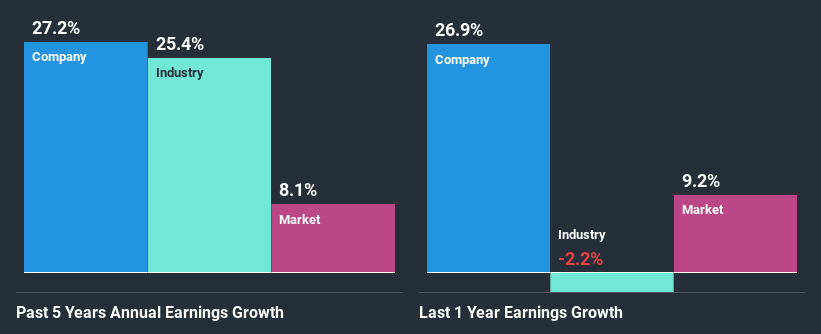- Belgium
- /
- Industrial REITs
- /
- ENXTBR:INTO
Intervest Offices & Warehouses nv's (EBR:INTO) Fundamentals Look Pretty Strong: Could The Market Be Wrong About The Stock?

With its stock down 5.5% over the past three months, it is easy to disregard Intervest Offices & Warehouses (EBR:INTO). However, a closer look at its sound financials might cause you to think again. Given that fundamentals usually drive long-term market outcomes, the company is worth looking at. In this article, we decided to focus on Intervest Offices & Warehouses' ROE.
Return on equity or ROE is an important factor to be considered by a shareholder because it tells them how effectively their capital is being reinvested. Simply put, it is used to assess the profitability of a company in relation to its equity capital.
Check out our latest analysis for Intervest Offices & Warehouses
How To Calculate Return On Equity?
The formula for ROE is:
Return on Equity = Net Profit (from continuing operations) ÷ Shareholders' Equity
So, based on the above formula, the ROE for Intervest Offices & Warehouses is:
11% = €58m ÷ €537m (Based on the trailing twelve months to September 2020).
The 'return' is the income the business earned over the last year. So, this means that for every €1 of its shareholder's investments, the company generates a profit of €0.11.
What Is The Relationship Between ROE And Earnings Growth?
So far, we've learned that ROE is a measure of a company's profitability. Depending on how much of these profits the company reinvests or "retains", and how effectively it does so, we are then able to assess a company’s earnings growth potential. Assuming everything else remains unchanged, the higher the ROE and profit retention, the higher the growth rate of a company compared to companies that don't necessarily bear these characteristics.
Intervest Offices & Warehouses' Earnings Growth And 11% ROE
To begin with, Intervest Offices & Warehouses seems to have a respectable ROE. Further, the company's ROE compares quite favorably to the industry average of 7.4%. This probably laid the ground for Intervest Offices & Warehouses' significant 27% net income growth seen over the past five years. We believe that there might also be other aspects that are positively influencing the company's earnings growth. Such as - high earnings retention or an efficient management in place.
Next, on comparing Intervest Offices & Warehouses' net income growth with the industry, we found that the company's reported growth is similar to the industry average growth rate of 25% in the same period.

Earnings growth is a huge factor in stock valuation. What investors need to determine next is if the expected earnings growth, or the lack of it, is already built into the share price. By doing so, they will have an idea if the stock is headed into clear blue waters or if swampy waters await. If you're wondering about Intervest Offices & Warehouses''s valuation, check out this gauge of its price-to-earnings ratio, as compared to its industry.
Is Intervest Offices & Warehouses Efficiently Re-investing Its Profits?
The three-year median payout ratio for Intervest Offices & Warehouses is 45%, which is moderately low. The company is retaining the remaining 55%. By the looks of it, the dividend is well covered and Intervest Offices & Warehouses is reinvesting its profits efficiently as evidenced by its exceptional growth which we discussed above.
Besides, Intervest Offices & Warehouses has been paying dividends for at least ten years or more. This shows that the company is committed to sharing profits with its shareholders. Our latest analyst data shows that the future payout ratio of the company is expected to rise to 88% over the next three years. Despite the higher expected payout ratio, the company's ROE is not expected to change by much.
Conclusion
In total, we are pretty happy with Intervest Offices & Warehouses' performance. Specifically, we like that the company is reinvesting a huge chunk of its profits at a high rate of return. This of course has caused the company to see substantial growth in its earnings. If the company continues to grow its earnings the way it has, that could have a positive impact on its share price given how earnings per share influence long-term share prices. Remember, the price of a stock is also dependent on the perceived risk. Therefore investors must keep themselves informed about the risks involved before investing in any company. To know the 3 risks we have identified for Intervest Offices & Warehouses visit our risks dashboard for free.
If you’re looking to trade Intervest Offices & Warehouses, open an account with the lowest-cost* platform trusted by professionals, Interactive Brokers. Their clients from over 200 countries and territories trade stocks, options, futures, forex, bonds and funds worldwide from a single integrated account. Promoted
New: AI Stock Screener & Alerts
Our new AI Stock Screener scans the market every day to uncover opportunities.
• Dividend Powerhouses (3%+ Yield)
• Undervalued Small Caps with Insider Buying
• High growth Tech and AI Companies
Or build your own from over 50 metrics.
This article by Simply Wall St is general in nature. It does not constitute a recommendation to buy or sell any stock, and does not take account of your objectives, or your financial situation. We aim to bring you long-term focused analysis driven by fundamental data. Note that our analysis may not factor in the latest price-sensitive company announcements or qualitative material. Simply Wall St has no position in any stocks mentioned.
*Interactive Brokers Rated Lowest Cost Broker by StockBrokers.com Annual Online Review 2020
Have feedback on this article? Concerned about the content? Get in touch with us directly. Alternatively, email editorial-team (at) simplywallst.com.
About ENXTBR:INTO
Intervest Offices & Warehouses
Intervest Offices & Warehouses NV (referred to hereafter as “Intervest”) is a public regulated real estate company (RREC) under Belgian law, founded in 1996, of which the shares have been listed on Euronext Brussels (INTO) since 1999.
Reasonable growth potential second-rate dividend payer.

